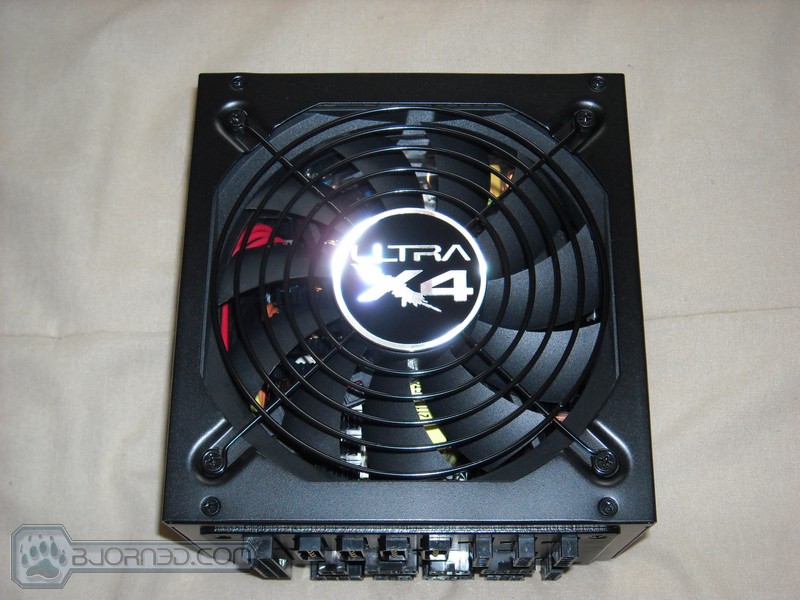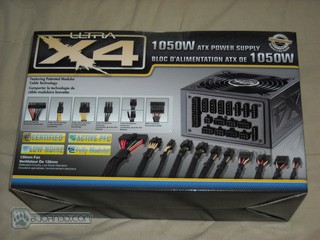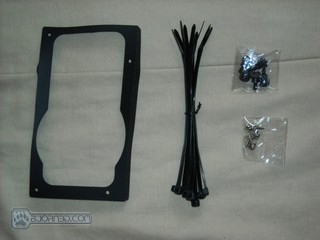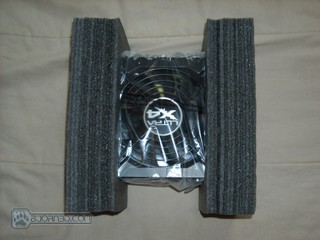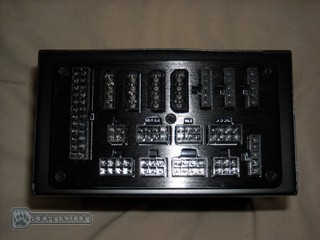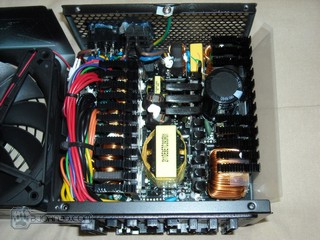The Ultra X3 series of PSU’s have quickly gained a name for themselves, but now Ultra is ready to release a new line appropriately titled Ultra X4. Today we have the 1050 watt model.
introduction
Ultra has quickly made a name for themselves in the PSU market with the introduction of their X3 series. It has been quite awhile since the introduction of the X3 series, so now Ultra is ready to launch their new X4 series of PSU’s. One of the big issues with the X3 series was its efficiency. Under a full load the PSU would fall to 78% efficiency. While this isn’t really bad, its not enough to be certified for 80+. This time around Ultra has went all the way, and obtained the 80+ certification.
Ultra could have easily stopped there, and we would have been perfectly fine with it, but they decided to add just one more thing, 50 more watts. While thats not a whole lot, it certainly makes the PSU stand out just a little bit more than a 1000 watt PSU. Today we will put the X4 to the ultimate test, and see if it really improves on the X3 series of PSU’s.
Features
Protecting Your Investment
- Integrated short circuit protection and thermal overload sensors automatically protects the PC when surges or overheating become an issue.
- 135mm fan improves airflow throughout the chassis while keeping noise at a minimum
Hassle-Free Installation
- With Ultra’s patented Modular Design, you only connect the cables which you need increasing airflow and giving your chasis that nice clean-look
Solid Support
- With 3 year standard and lifetime warranty availabhle upon registration, Ultra’s customer service meets teh highest industry standards.
You can see here that Ultra has included many key features includeing a 135mm fan. This large fan will ensure the PSU runs cool, and thus keep your components running with clean power. The modular design insures that you wont have a bunch of random unneeded cables clogging up the airflow in your case.
Specifications
| Max output current |
+5V |
+3.3V | +12V | -12V | +5VSB |
|
30A |
24A | 76A | 0.5A | 3A | |
| Max Combined Wattage | 170W | 912W | 6W | 15W | |
| 1029W | 21W | ||||
|
1050W |
|||||
We see that Ultra rates this PSU for exactly how much wattage it can output. This is a little weird, as many manufacturers under rate their PSU’s
WHAT ABOUT THEM RAILS?
We have all, no doubt, been told that when purchasing a power supply that the number to look for is the amps on the 12V rail. What are each of the different rails for though, and why is the 12V rail typically the most important? Why the heck are they called rails? Let’s take at look at each and see.
-12V – This rail is pretty much obsolete now and is only kept on to provide backward compatibility with older hardware. Some older types of serial port circuits required both -12V and +12V voltages, but since almost no one except industrial users use serial ports anymore you as a typical home user can pretty much disregard this rail.
-5V – Again this is another obsolete rail, the -5V was used for old school floppy controllers and some ISA bus cards. Again, no need for the typical home user to worry about this rail.
0V – Though not listed on any manufacturer spec sheet, every power supply has a 0V ground line. The ground signal is used to complete circuits with other voltages and provide a plane of reference against which other voltages are measured.
+3.3V – Finally we are starting to get into something useful! The +3.3V rail was introduced with the ATX form factor in order to power second generation Pentium chips. Previously the CPU was powered by the +5V rail (along with the system memory and everything else on the motherboard), but a reduced voltage was needed in order to reduce power consumption as the chips got faster. Until just recently, the +3.3V was used to exclusively power the CPU as well as some types of system memory, AGP video cards and other circuits.
+ 5V – As mentioned above, the +5V used to run the motherboard, CPU and the majority of other system components on older pre ATX based systems. On newer systems, many of the components have migrated to either the +3.3V or +12V rails, but the motherboard and many of its onboard components still use the +5V rail so it is of importance to the typical home user.
+5V SB – The +5V Standby or “Soft Power” signal carries the same output level as the +5V rail but is independent and is always on, even when the computer is turned off. This rail allows for two things. First, it allows the motherboard to control the power supply when it is off by enabling features such as wakeup from sleep mode, or wake on LAN technology to function. It also is what allows Windows to turn your computer off automatically on shutdown as opposed to previous AT supplies where you had to bend over and push the button. Every standard ATX power supply on the market will include this rail.
+ 12V – The +12V, also known as the mother of all rails, is now used to power the most demanding components in your system including the CPU, hard drives, cooling fans, and graphics cards. Historically the +12V rail was used only to power drives and cooling fans. With the introduction of the 4-pin CPU plug on P4 motherboards and then eventually AMD based motherboards, in order to supply newer power hungry CPUs, the +12V rail suddenly started to grow in importance. Today, dual core based motherboard require an 8-pin +12V connector to supply their power needs. High end GPU cards have also jumped on the +12V rail, which has required PSU makers to adapt. Where previously there was only a single +12V rail, there are now two or more, each designated to power specific devices in order to ensure that nothing is underpowered.
Now as to why they are called rails, the best explanation that I can find is that the term comes from the wacky world of electronics and it refers to a long metal bar or strip that is used to provide a particular voltage level. Perhaps someone with a deeper understanding of all things electrical could let me know whether or not that is true.
ATX 12V V2.2 Standard
ATX 2.20
2.20 is where we currently stand as of March 2005. It was released the same month as the short lived 2.1 revision which is why you won’t see any units bearing that standard. The 2.20 again increased the efficiency requirements which now stand at a minimum of 65% or greater and a recommended level of 75% or greater. The +5VSB rail has also been increased to 2.5A
In short any power supply post 2.0 will do the job for you. The biggest advantage of purchasing a latter standard model would seem to be the increase in efficiency rating.
EPS12v Standard
The EPS12V specification is one of those standards that most people have heard about, but very few know what it actually does. The EPS spec itself is defined in the Intel Server System Infrastructure (SSI) spec and is currently at v2.1.
The EPS12V spec dictates that Power Supply units must have a 24pin 12V connector as well as one additional 8-pin 12V connector. If a PSU is noted as EPS12V compliant you can be assured that it will have all the connections you need to power your new dual core based system, however it should also be noted that units do not necessarily have to meet EPS12V spec to include an 8-pin 12V connector.
Enough of the boring stuff lets get on to some Packaging and Bundled Accessories!
Pictures & Impressions
Ultra choose to do a traditional box design. They have included a picture of the product, and show cased a few select features like the 80+ certification. They also choose to clearly label all of the cables that the PSU comes with.
Here is a picture of the included accessories. As you would expect, Ultra has bundled all of the needed cables. They have also included a power cable, and a manual for reference. Worth noting is an included Molex to 3 pin fan adapter. I have never seen one bundled with a power supply. and this is just a nice surprise for those who need more fan connections without buying a fan controller.
Here are a few of the stragglers. Ultra has included a pad to keep your PSU from vibrating, but the PSU already doesn’t make a lot of noise, so I doubt this will help much at all. As always there are some zip ties to help get you started with cable management. There are also thumb screws and normal screws, so you get to choose what type you want to use depending on which type you like to use.
Ultra did a good job packaging the PSU. As you can see there are two styrofoam covers on the end that keep it from moving, and a bag over it to keep it from getting all scratched up.
A nice beauty shot of the PSU for all of you out there. The Ultra X4 logo definitely looks pretty cool. This will surely be displayed for all to see.
This is where you plug everything in. Unlike some manufacturers such as Corsair, Ultra chooses to use a design that looks like the physical plug. This may get some of you confused, but each cable is clearly labeled, so you should be able to figure it out. On top of that, from what I gather it doesn’t matter which way you have the cable as long as it plugs in.
Ultra also did a great job designing the top of the PSU. The X4 logo looks just as good here as it does on the side of the PSU. The fan looks to be of pretty good quality. This is a good thing since thats what keeps your PSU from popping.
The components look to be pretty high quality, so you can be pretty sure that this PSU will not randomly fail even in an intense game session. Now lets go see what the voltages look like.
METHODOLOGY
| Test Rig | |
| Case Type |
Cooler Master HAF932 |
| CPU | Intel I7 920 @ 3.8 |
| Motherboard | Intel SmackOver X58 |
| Ram | 6 GB DDR3 1600 @ 1600, 9-9-9-24 |
| CPU Cooler | D-Tek Fuzion w/ acrylic top |
| Hard Drives | Corsair P64 64 GB (2x) WD SE16 750 GB |
| Optical | Lite-On DVD R/W |
| GPU |
Leadtek GTX275 |
| Case Fan |
One Front 230mm Intake |
| Testing PSU |
Corsair HX850w |
For the tests I used 3DMark Vantage to achieve a game like experience, which should lead to the maximum load possible. For the idle tests I manually turned the PSU on with nothing attached to it. A Kill-A-Watt watt meter was used to measure the wattage being drawn by the computer from the wall socket. A Craftsman digital multimeter was used to measure the voltages on the connector to ensure that the most accurate result was obtained. To get the Power Factor Correction, I had to run the PSU with the minimal components, since it will not give this with nothing plugged in.
The current ATX 2.2 specifications allow for the following variation in voltage outputs:
- 3.3 Volt Rail: 3.135 – 3.465V
- 5 Volt Rail: 4.75V – 5.25V
- 12 Volt Rail: 11.4V – 12.6V
RESULTS
| Corsair HX850w |
Kingwin 1000w |
Ultra X4 1050 |
||||||
| OutPut Power | Idle | Load | OutPut Power | Idle | Load | OutPut Power | Idle | Load |
| 12 volt | 12.18 | 12.21 | 12 volt | 12.19 | 12.17 | 12 volt | 12.42 | 12.32 |
| 5 volt | 5.1 | 5.1 | 5 volt | 5.14 | 5.15 | 5 volt | 4.96 | 5.1 |
| 3.33 volt | 3.34 | 3.324 | 3.33 volt | 3.412 | 3.14 | 3.33 volt | 3.402 | 3.362 |
| PFC | 0.99 | 0.99 | PFC | 0.98 | 0.99 | PFC | 0.97 | 0.96 |
The X4 had no issue matching up with the Silverstone, but had a sub par Power Factor Correction. Overall the X4 easily was within ATX 2.2 standards, which is exactly what you should look for in a PSU. Though the PFC was lower than we like to see on PSU’s.
Conclusion
The Ultra X4 1050 watt is certainly a cabable PSU, but is it the best PSU in its range? The short answer is no. While we praise Ultra for improving the efficency, the voltages and PFC where not as good as the Corsair HX850 PSU. It really is too much to ask to have Ultra improve all feilds of the X series of PSU’s with just one revision. The efficency is deffinatly the first step. Hopefully Ultra will decide to make an X5 series that further increases the efficency, and keeps the voltages and PFC up. For now the X4 is a good improvement.
While the X3 was also modular, it is nice to see Ultra not drop the feature. For many a non modular PSU is just unacceptable. I happen to be one of those people, becuase I would not know where to hide all of the extra cables that where not used.The extra wattage boost of 50 watts is also a nice boost. This will certainly give you that little boost to ensure that your dual GPU configuration is fed enough power. This goes for any component for that matter. Overall the X4 did a great job, but didn’t quite measure up to a few of the other high end PSU’s.
We are using this scale with our scoring system to provide additional feedback beyond a flat score. Please note that the final score isn’t an aggregate average of the rating system.
- Performance 7
- Value 8
- Quality 8
- Warranty 9
- Features 8
- Innovation 7
Pros:
+ Good Performance
+ 1050 Watts Of Power
+ Good Quality
Cons:
– PFC Is Low
The Ultra X4 1050w is a pretty good PSU that has not only efficency on its side, but keeps voltages in check. This is why the card received a 7.5 out of 10, and the Bjorn3D Seal of Approval.
 Bjorn3D.com Bjorn3d.com – Satisfying Your Daily Tech Cravings Since 1996
Bjorn3D.com Bjorn3d.com – Satisfying Your Daily Tech Cravings Since 1996
